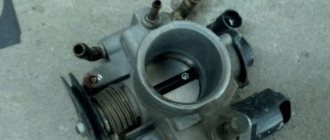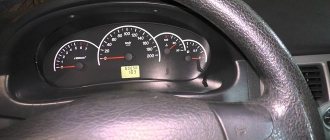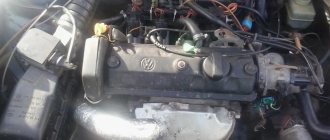rub. Participating: 7 people. End:29-5-2020 18:05
[td]Edited by: Skladchik at 29-4-2020 18:28 We present to your attention the fund that we managed to collect during quarantine.Everything is neatly arranged in folders with the most current firmware today.The pool included three firmware packages:The first package is the latest firmware from different authors for popular car brands - List of files Spring 2022.txt (439.27 KB, Downloads: 346) The second package is a collection of firmware for Renault cars of different authors and different years - List of files Collection Renault.txt (108.03 KB , Downloads: 107) And the third package is a convenient collection of firmware for cars of domestic production from different authors - List of files Collection_2 Gas VAZ UAZ.txt (530.64 KB, Downloads: 237) The cost of participation in the pool is 5,000 rubles, the first 10 to pay a 10% discount. Click join button and wait for payment details in PM.
Why does Lada Granta have difficulty starting when cold?
Car : Lada Granta. Asks : Firsov Maxim. The essence of the question : Is the car difficult to start when cold?
Please tell me why, when my car, a Lada Granta, sits overnight and the engine cools down, the engine does not start the first time? Although if you drive it all day, then such problems are not observed, this only happens when it’s “cold”.
The main reasons for poor cold starting.
Judging by the problem described above, there may be several reasons for the malfunction, and you need to start with the one that you think can be solved most quickly.
The reasons may lie in the following:
Location of spark plugs and protective caps
This is a list of the main reasons why an engine may start poorly when cold.
Service or DIY repair?
Some causes can be diagnosed by yourself, but most of them will require replacement parts. Usually electricians have “guaranteed working” spark plugs, armored wires, and also if they have special ones. equipment (CO emission standards), you can check the operation of the ignition.
In order to solve the problem, contact a specialized car service for diagnostics, or do it yourself if you have a diagnostic cable and suitable software.
Source
Possible failure factors
If this situation arose for the first time at home in the garage with fuel in the tank, a working battery, after a short stay, do not panic. The reasons for the engine failure to start most likely lie in the following components:
- immobilizer;
- starter;
- battery;
- high voltage wires;
- electronic control unit;
- spark plug;
- gasoline pump;
- crankshaft sensor;
- coolant temperature sensor.
It will not be possible to immediately determine the essence of the breakdown, especially without certain experience or skills in working with fuel equipment or automotive electronics, in a garage. It is necessary to methodically check each node given above. At the same time, find out its functional characteristics, structure, operating principle. We provide an algorithm for checking each device.
Why is the car difficult to start when the injector is cold?
1200 rub. for the photo report
We pay for photo reports on car repairs. Earnings from 10,000 rubles/month.
Write:
“It doesn’t start well when it’s cold,” such complaints can be heard from men in cold weather when discussing cars. In this case, different symptoms and behavior may be described, but the problems due to which the car is difficult to start when cold are, as a rule, almost the same. The reasons for difficult starting may differ depending on the type of engine; since gasoline engines (injector or carburetor) have their own reasons, and diesel engines will, of course, have others. In this article we will look at the most common cases of problems such as:
Reasons why it is difficult to start when cold
It is important to distinguish between situations in which problems arise: the car is hot and has difficulty starting, it has difficulty starting after being idle, when it cools down, (especially in the morning) if it refuses to start in cold weather. They all have their own nuances and reasons that should be considered separately .
We will understand in general terms what reasons lead specifically to poor starting of a cold engine. Usually one or two rotations of the starter armature shaft are enough to start a car in good condition. If this cannot be done, you need to look for why.
Main reasons:
| Causes | Carburetor | Injector | Diesel |
| Low fuel quality | |||
| Poor fuel pump performance | |||
| Clogged fuel filter | |||
| Low fuel pressure | |||
| Low fuel level in carburetor | |||
| The pressure regulator in the fuel line is faulty | |||
| Air leak | |||
| Poor condition of spark plugs | |||
| Malfunction of high-voltage wires or ignition coils | |||
| Dirty throttle valve | |||
| Idle air valve contaminated | |||
| Malfunction of air sensor indicators | |||
| Engine temperature sensor glitch | |||
| Valve clearances are knocked down or incorrectly set | |||
| Incorrect oil viscosity (too thick) | |||
| Low battery charge |
In addition to these cases, there may be others, less common, but equally significant. We will also mention them below.
Troubleshooting Tips
On gasoline engines, an indicator that it is difficult to start and stalls when cold can be a spark plug . We unscrew it and look: if it’s flooded, it overflows, we look further down the points; dry - lean mixture, we also sort out the options. This method of analysis will allow you to start finding out with simpler ones and gradually approach more complex reasons for poor engine starting when cold, rather than looking for them in the fuel pump, disassembling the injector, getting into the timing mechanism, opening the cylinder block, etc.
But for a diesel engine, the first on the list of faults will be weak compression . So owners of diesel cars should pay special attention to it. In second place is the quality of the fuel or its inconsistency with the season, and in third place are glow plugs .
Tips for starting the engine in cold weather
FakeHeader
Comments 45
So it's not about the spark plugs or the throttle or the valves. The jamb is constructive, pumped over from previous models of vases. Since the fuel rail is located in close proximity to the exhaust tract, after trips it heats up due to the heat emanating from the cat or spider, because of this, the gasoline heats up and boils inside the ramp, therefore the pressure in the ramp drops and the car takes a long time to start hot. I personally start it this way: I turn the key to the first position several times 2-3 times, wait until the fuel pump relay clicks, and then I start it 4 times, and what do you think... It starts perfectly...
The throttle position sensor needs to be replaced.
The problem has been known for a long time and there is one more thing, replacing the coolant temperature sensor, which is located in the thermostat, changed the problem, no such problem yet. If you have a question about how a sensor can affect startup, then google it. True, the problem always arose on a warm engine, but on a cold one it always started the first time.
I got this hemorrhoid after installing Denso candles ///
I’ve had it since new and it’s not going anywhere))
What you described does not help, because... I carry out these procedures regularly, but the problem is still present.
This happens to me, but I have nothing to clean since everything is already clean and everything has been changed, but the problem remains.
one of the last ones worth
8bug ones seem to take a long time to turn, at work and at my wife’s it’s the same thing, my 16kl starts with half a kick even with a decrepit battery
Late 2015, mileage 30k, gasoline 95, fall/winter/cold spring — auto start. It never started. The rest of the time with the key, with the clutch depressed. It never started.
At 70K mileage, such garbage appeared that sometimes it could not start from autostart. And at a mileage of 20-30 it happened that the second time it started and the starter turned for a long time (regardless of the temperature)
In my opinion, these are all VAZ genes passed on from generation to generation. This happened on a tag with a mileage of 200,000+ and the same thing is observed on a grant with mileage “recently left the showroom”))
Yes, this fact exists. The solutions described are not a panacea. A design feature that does not depend on service life. But bad spark plugs and gasoline will manifest themselves in any car in one way or another, and replacing the air filter will not at all affect the starting of the car. Over almost 6 years of operation, this defect has not increased or decreased. Didn't adjust the valves 70 t.km. because the clearances were normal (dynamic driving reduces the need for valve adjustment). But literally not long ago, the adjustment of the valves (one was out of order) coincided with the next independent maintenance (replacement of oil, spark plugs, filters), as a result, the starting situation did not change. Your candles don't look very good. Mine are always dry, even after 40 thousand kilometers on one set. And the damper is not the reason, because... Since then, the problem has appeared (and even during dynamic driving this is not required, but it will manifest itself in floating speeds, deterioration in dynamics, etc.). I don’t even dare call it a problem or a defect, rather a feature of this car because... appears extremely rarely.
The injector does not start well when cold
The first thing you should pay attention to when an injection car is performing poorly is the sensors. Failure of some of them leads to difficulty starting the engine, since incorrect signals are sent to the ECU. It is usually difficult to start when cold due to :
Often there is a problem with cold starting due to the fault of the fuel pressure regulator . Well, of course, whether it’s an injector or a carburetor, when a cold car doesn’t start well, if it stalls, the speed jumps, but after warming up everything is fine, then it’s imperative to check the condition of the spark plugs, and use a multimeter to check the coils and explosive wires.
Leaking injectors cause a lot of trouble when it’s hot outside, the car will have difficulty starting on a hot engine, and in the cold season a dripping injector will cause difficulty starting in the morning . To test this theory, it is enough to simply release the pressure from the vehicle in the evening so that there is nothing to drip, and look at the result in the morning.
We cannot exclude such a banal problem as air leaks in the power system - it complicates starting a cold engine. Also pay attention to the fuel poured into the tank, since its quality greatly affects engine starting.
On cars such as the Audi 80 (with a mechanical injector), we first check the starting injector.
Gasoline pump
In winter, fuel pump interruptions increase. It is clear why this happens - due to low temperatures. The starter turns the flywheel, but you can’t hear the fuel pump running, and the “exclamation mark” flashes on the instrument panel. It is necessary to immediately measure the pressure in the fuel supply system. Under the hood, on the ramp with the injectors, there is a cap with a nipple attached to it. By clicking on it, we will see how fuel splashes out. If this happens, the fuel pump is working.
The relay may also break. Inside the transmission tunnel on the passenger side there is a casing where the power coils are located. They need to be warmed up or tapped. The serviceability of the fuel pump is determined by checking the voltage. The multimeter reading should be around 12 V. If this is not the case, check the fuses and relays.
The carburetor does not start well when cold
Most of the reasons that an engine with a carburetor does not start well, or does not start at all, is due to malfunctions of such elements of the ignition system as: spark plugs, explosive wires, coil or battery. Therefore , the first thing to do is to unscrew the spark plugs - if they are wet, then the electrician is to blame.
The main reasons why the carburetor does not start when cold:
Of course, if you pump up gasoline before starting and pull out the choke more, it will start better, but all these tips are relevant when the carburetor is correctly configured and there are no problems with the switch or spark plugs.
Advice from an experienced VAZ 2110 car owner: “When the engine does not start on a cold engine, you need to smoothly press the gas pedal all the way, turn the starter and release the pedal back, as soon as it grabs, keep the gas in the same position until it warms up.”
Let's look at some typical cases when it won't start when cold:
Spark plug
Order in electronics means the reasons lie in the candles. During winter operation of the car, they often flood. Low temperatures reduce compression, the engine is simply not able to start immediately. The battery often discharges in the cold, unable to provide a powerful charging spark. The wires and the spark plugs themselves may be faulty.
There is an easy way to dry candles. Press the gas pedal completely to the floor and crank the engine with the starter two times or more. Usually after such an operation the engine starts actively. If this does not happen, you need to dry the candles more thoroughly. Immediately dismantle them, clean them from carbon deposits, check them, adjust the gaps, dry them with a hairdryer or in the oven. You can gently heat it with a blowtorch.
Difficult to start on cold diesel
As you know, starting a diesel engine occurs due to temperature and compression, therefore, if there are no problems with the battery and starter, there may be 3 main ways to find the reason why a diesel engine does not start well in the morning when it’s cold:
One of the reasons that a diesel engine does not start when cold in particular, and poor diesel starting in general, is poor compression . If it doesn’t start in the morning, but seizes from the pushrod, and then there is blue smoke for a certain time, then this is 90% low compression.
Checking engine compression
Checking engine compression with a compression gauge and without instruments with your own hands. How to measure compression in gasoline and diesel engines. Compression diagnostics. More details
An equally common case is when the owner of a car with a diesel engine cannot start a cold engine, but a hot one starts without problems - if there is no glow on the spark plugs . Glow plugs heat diesel fuel until the diesel engine reaches operating temperature completely.
There may be three options why the candles do not work
3 options for checking glow plugs
To check diesel spark plugs, you can choose several methods :
If the spark plugs are working and they are properly supplied with power when the ignition is turned on, then in some cases it is necessary to check the valve clearances. Over time, they become confused and do not close completely when the internal combustion engine is cold, but if you start it and warm it up, they close up and the engine starts normally when it is hot.
Faulty diesel injectors , as a result of natural wear or contamination (sulfur and other impurities), are an equally important aspect. In some cases, the injectors throw a lot of fuel into the return line (you need to do a test) or the fuel filter is dirty.
Interruptions in the fuel supply make it much more difficult to start the engine. So, if the diesel engine stops starting in the morning, regardless of the temperature outside, the diesel fuel is leaving (the return valve does not hold), or it is sucking air, other options are less likely! Air entering the fuel system can cause the diesel engine to have difficulty starting and stalling.
Fuel is out of season or contains foreign impurities . When it is cold outside and the diesel engine does not start or immediately stalls after starting, then the problem may be in the fuel. DT requires a seasonal transition to “summer”, “winter” and even “arctic” (for especially cold regions) diesel fuel. A diesel engine does not start in winter because unprepared summer diesel fuel in the cold turns into a waxed gel in the fuel tank and fuel lines, and also clogs the fuel filter.
In this case, starting the diesel engine helps by heating the fuel system and replacing the fuel filter. Frozen water on the filter element presents no less difficulties. To prevent water accumulation in the fuel system, you can pour a little alcohol or a special diesel fuel additive into the tank, called a dehydrator.
Tips for diesel car owners:
10 reasons why diesel engines have trouble starting when cold
If a diesel engine has trouble starting when cold, the reasons can be collected in a single list of ten points:
I hope that all of the above will help you, and if it does not solve the problem of starting a cold engine, it will at least point you on the right path to eliminating it on your own or with the help of a specialist.
Difficulties starting the engine “cold” arise in different situations. Firstly, leaving the car in the cold for a long time. This could be one night or several weekends. Secondly, the cooling of the internal combustion engine after it has warmed up to operating temperatures, stopped and attempted to restart after some time.
Difficulty starting gasoline and diesel engines has similar causes, but manifests itself in different ways. This applies to engines with carburetor and injection fuel supply systems that have design differences.
In this article we will talk about common problems that lead to additional difficulties when trying to start the engine “cold”, we will give recommendations for owners of cars with power plants running on gasoline and heavy fuel.
Let's sum it up
The reasons for unsatisfactory startup of the power plant, as already mentioned, are very diverse. We have listed the most common ones and given recommendations on how to eliminate some of them. If you are the owner of a Lada Kalina, which has an 8-valve power plant, and have encountered this problem, write about it in the comments. The review will be useful, especially if it contains an example of a non-standard solution to a problematic unit start-up.
Hello, help me find the problem. Car Lada Granta Standard 2012 1.6l 8kl. engine 11183. Brains I444GG02 11183-1411020-62 M74, CAN, pre-production version, LADA GRANTA 1.6L 8V.
1. Firstly, it doesn’t start well the first time.
2. Secondly, floating speeds and uneven operation of the engine and exhaust system began to fluctuate. At an engine temperature of 60-65 degrees, the revolutions float in the range from 870 to 950; at an engine temperature above 100 degrees, the revolutions remain within the range of 820-850. When I pressed the clutch, the revs fluctuated and fluctuated. All sensors are working, no errors. The diagnostics revealed nothing, everything works ideally, there are no problems with anything. Cleaned the throttle, changed the clutch pedal position sensor. Changed the spark plugs. Changed the armor wires. I tightened all the tubes that I have. The air flow sensor is working. The absorber valve is working. The ignition coil is working. In short, I double-checked everything, looked at everything more than once, but the problem never went away. Whatever they did.
I am the owner of Lada Granta. I am writing about my car.
Preparatory activities
To simplify your task in finding the cause of the malfunction, check the following:
1. Presence of exhaust gases.
There should be light smoke coming from the exhaust system when the starter rotates. It indicates that fuel is entering the cylinders.
2. Battery charge level.
A completely discharged battery is one of the most common reasons why a car engine will not start. Therefore, we check the battery charge level.
3. Serviceability of the starter (the engine should spin without failure).
If the starter does not spin the crankshaft, then a dead battery is to blame. If not, then the problem lies elsewhere. For example, the contact between the ground and the starter housing has oxidized.
Crankshaft and coolant sensors
Sometimes the car does not start even if the starter, fuel pump are working properly, or the control unit, spark plugs, and battery are in order. Why is this happening? To understand, check the crankshaft sensor. It is quite possible that it is on the verge of wear. The sensor is connected to a multimeter, and a screwdriver is moved along its end.
Voltage surges should be reflected on the device. There should be a resistance of 750 ohms between the contacts. If there is a discrepancy, the crankshaft sensor must be replaced.
A faulty coolant temperature sensor gives false readings, causing the on-board electronics to block startup. It must be replaced.
The main causes of problems during cold engine starts
Low quality fuel
The likelihood of refueling a car with low-quality fuel at certified gas stations in large cities is very low. It is much easier to encounter counterfeit products at little-known gas stations on the highways or when purchasing fuel second-hand. Such fuel does not pass quality control and contains a large amount of impurities that contaminate filters and fuel pipe channels. As a result, the pressure in the system decreases and the car does not start.
The use of low octane gasoline is determined by the following criteria:
In diesel engines, a problem may arise due to the fuel selected “out of season.” An owner who uses diesel fuel for the summer during the winter period of operation of the vehicle will encounter difficulties. The main reason is the discrepancy between the physical and chemical properties of the fuel and the operating conditions.
Summer diesel fuel at subzero temperatures turns into a viscous and thick mass that clogs both the fuel line and the filter. Its chemical composition is not suitable for working in such conditions. In this situation, preheating the fuel system and installing a new filter instead of the dirty old one will help.
Poor condition of spark plugs
Remove the spark plugs after an unsuccessful attempt to start the engine. The presence of strong smudges, as a rule, indicates a malfunction with the ignition system and a violation of the tightness of the injectors.
First you need to inspect the external condition of the candles. Check their integrity. You should look at the high voltage wires. There should be no defects.
A dry spark plug indicates that fuel is not getting into the cylinder.
Problems with the fuel pump
Malfunctions in the operation of the pump lead to the inability to pump the required level of pressure. The main reason for this unpleasant phenomenon is a clogged filter. If the filter element is dirty, the required pressure is not created in the ramp. Accordingly, the car will not start. The internal combustion engine receives a lean fuel mixture, which also does not ignite due to the too low temperature in the cylinders.
To find a fault, we check the pressure in the rail and directly in the pump. Engines with fuel injection may also have coked injectors.
To check the fuel pump, turn on the ignition. If everything is in order, you will hear a characteristic buzzing sound from the side of the fuel tank. It lasts a couple of seconds. After the fuel supply stops, the required pressure will build up in the fuel rail. The pumping equipment should automatically turn off.
Presence of air leaks
The air supply system must be sealed. To check its supply, look at the condition of the line. There should be no cracks, breaks or bends that lead to leaks or impede the passage of air. Traces of gasoline leaks are evidence of leaking fuel lines.
Error when choosing engine oil
It is allowed by inexperienced car owners. Incorrectly selected motor oil viscosity grade leads to problems when starting the internal combustion engine. Liquids that are too thick freeze at subzero temperatures. As a result, difficulties arise with its passage through the oil channels.
Idle air valve malfunction
The idle air valve is an electromagnetic element with a rod. Controlled by the powertrain ECU. When it’s frosty outside, the internal combustion engine temperature sensor transmits the corresponding information to the ECU, which signals this to the idle air valve. Its rod extends to slightly open the throttle valve. As a result, engine speed increases when not warmed up. When the internal combustion engine is warm, the reverse process occurs. As a result, the rod returns to its original position. Engine speed decreases.
If the idle air valve fails, the rod either remains motionless or does not extend completely. Problems may be associated with a breakdown of the coil located inside the sensor housing, or caused by severe contamination of the sensor.
Valve clearance violation
A common reason why the engine starts poorly in both carburetor and injection engines, especially when cold.
8. Damage to explosive wires, contamination of the throttle valve.
The presence of a large amount of dirt in the throttle valve interferes with the process of regulating the air supply. This is a serious problem for starting the engine. The fact is that the internal combustion engine receives untreated air containing dust and oil deposits, which do not allow the formation of a fuel mixture of the required consistency.
These malfunctions are typical for diesel and gasoline power units. However, there are several problems that owners of vehicles with certain engine designs have to face.
Carburetor starting problems
For carburetor internal combustion engines, the most common failures are in the ignition system. This applies to high-voltage wires, switch, breaker-distributor, coil. The engine may not start due to the battery, damaged pump membrane or starter.
There are a lot of reasons. However, it is better to start your search with candles. Unscrew the devices for igniting the air-fuel mixture (FA). If they are wet, then look for a fault in the car's electrical system.
When cold starting a carburetor power unit, you can cheat. For example, pump in a little more gasoline fuel or increase the suction. After these procedures, the power unit starts better. However, the car owner needs to be sure that the carburetor is fully functional and has the correct settings. Problems with the switch or faulty spark plugs can negate the owner’s efforts.
Something else useful for you:
Video: Why is it difficult to start a cold carburetor?
In DAAZ and Solex carburetors the following phenomenon can be observed: the engine starts, and after a while it stalls. If the spark plugs are flooded, then the starting device, or rather its diaphragm, is to blame for stopping the internal combustion engine.
Let's look at common cases when problems arise with starting a carburetor-type engine.
For owners of cars with carburetor internal combustion engines who encounter problems during cold starts, it is advisable to check possible fault locations in the following order:
There is another useful tip that will be useful to owners of domestic cars. Try to slowly (without jerking) press the gas pedal and turn the starter. Then release the gas to find the moment when the clutch “grabs”. To start the engine, keep the gas pedal in the found position until it warms up.
The starter does not turn
If you are sure that the problem is not in the APS, then most likely the starter is not working. The Lada Granta is equipped with a cable-driven gearbox and the starter often acts up, especially with a new gearbox.
It is very easy to find out that the starter is not turning: when you turn the ignition key, you do not hear the specific sound of its operation.
Sometimes a car with a robot does not turn the starter, this is due to a weak battery, we recommend charging it and trying again, although sometimes it helps to simply remove and put on the terminals.
The main causes of starter failure are the battery, the starter itself, or problems in the switching circuit.
The main causes and troubleshooting of the starter:
- The battery is low or damaged. It is not difficult to check its condition: you will immediately notice this by the fact that the light bulbs and panel sensors do not light up, and when you start the engine, you hear a specific crackling noise under the hood. But if they light up normally, then to be sure, you need to turn on the headlights to high beam and evaluate their brightness; if the light is dim, then the battery is not completely discharged, but its power is not enough to start the starter. To resolve the problem, you need to charge or replace the battery.
- Problems with battery terminals, faulty wiring, insufficient contact with ground. The terminals may be loose, poorly seated, or oxidized. To fix this problem, you need to clean it, thoroughly coat it with machine Vaseline and tighten the bolt on the starter and the ground on the thermostat stud. Using a multi-meter you need to check the ground for breakdowns. To do this, you need to switch it to voltmeter mode and connect one wire to the starter “ground” on the thermostat pin, and the other to the engine; there should be no voltage.
- If everything is normal in the circuit, you need to remove the starter itself and look at the operation of the traction relay. If you turn the key to the second position, the relay does not work and you cannot hear a click. This can be checked by applying voltage to the contact of the traction relay. The relay, wiring or ignition switch needs to be replaced. If there is current, but the starter still does not turn, then the problem is in itself.
- Faults in the starter itself. It is necessary to inspect, there may be damage to the flywheel teeth or starter gear, repair or replace if necessary.
- The commutator on the starter was burnt, the brushes were severely worn, and there was a break in the armature winding. How to determine this? The armature does not rotate at all or too slowly. Inspect the traction relay and supply current from the battery to the starter contact directly. To fix the problem, it is necessary to repair or replace the armature or the starter itself.
- Poor performance and clutch slipping. This happens when the starter spins but the flywheel does not. In this case, change the clutch or the starter itself.
If the starter turns, but the car does not start, you need to look further.
Possible faults
No matter how trivial it may sound, if the injector does not start, it means something has gone wrong. The success and speed of repair depends on how quickly and efficiently the problematic link in the car’s design can be identified. To better understand the essence of repair activities, it would be a good idea to pay attention to potential breakdowns. The basic list of the latter is as follows:
In addition to the breakdowns described above that can break the operation of the injector, the problem may lie in more trivial things. An example of this is a weak battery charge or lack of fuel in the tank. Considering just such incidents, before repairing a car, it is extremely important to exclude the possibility of their occurrence, so as not to waste extra time and nerves.
How to check the fuel system
It often happens in very humid weather that the fuel supply mechanisms break down. Water can seep into any crack and get onto the connectors of the injectors that spray gasoline in the combustion chamber, and into the gas tank through the O-ring of its neck cap. And even through the gasket of a submersible pump, which is installed directly into the tank.
Injectors are the easiest to diagnose. They are unscrewed and pulled out of the cylinder head. By pointing the injector nozzles away from the car, turn on the ignition for a couple of seconds, the pump starts working, and the nozzles should begin to spray gasoline. If spraying occurs, then everything is in order. It is worth checking the condition of the gasoline.
To do this check, unscrew the supply tube to the injector rail and, using a small, clean container, point the end of the tube into it. After turning on the pump for a few seconds, you need to assess the condition of the gasoline in the container for the presence of water. The appearance of water in the fuel means that the tank needs to be repaired. The flammable mixture is drained from it, allowed to dry completely and filled with clean fuel.
The procedure for returning the car to “life”
Let's say you find yourself in circumstances where the injection engine starts poorly or refuses to do so at all. There is no need to hesitate in such a situation - it is advisable to immediately begin resuscitation procedures. If you don’t have time to figure out the exact reason why the car doesn’t start well, then you should quickly carry out the following algorithm of actions:
In general, there are no particular difficulties in repairing a non-starting injector. The main thing in the process of such work is to act competently, in accordance with the procedure and possible vehicle malfunctions described above.
Prevention of injector breakdowns
Why the injection engine does not start and how to eliminate possible problems is now known to all readers of our resource. However, it is better to avoid such breakdowns, so let’s pay attention to ordinary procedures that, if carried out systematically, will help minimize the risks of all malfunctions. The simplest but most effective prevention consists of the following measures:
Perhaps this is where the most important information on today’s issue has come to an end. We hope the material presented above was useful and provided answers to your questions. Good luck in operating and maintaining your car!
Source











